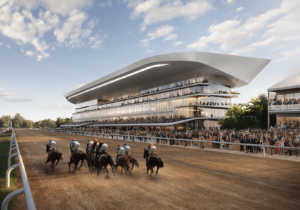After controversy and budget overruns surrounding Zaha Hadid‘s curvy design for Tokyo’s Olympic Stadium, the starchitect bowed out of the running. But Tokyo still needs a stadium, and two just-released proposals show a decidedly more traditional design.
The Japan Sports Council announced that the winner will be selected before the year is up, however, upon publishing details of the proposals, they have chosen to keep the submissions anonymous. That said, Nikkan Sports speculates that architects Toyo Ito and Kengo Kuma are the two practices vying for the lucrative commission.
Supposing this claim is true, one can quickly deduce that proposal “A” belongs to Kengo Uma and that proposal “B” is Toyo’ based on both firms’ previous projects and inherent style.
An in-depth insight into both the plans can be found on the council’s website (it’s all in Japanese) and it’s clear that both submissions clearly outline costs and construction details—a hard lesson learned after Hadid’s proposal, which was vetoed by the council, after it spiralled up to $2 billion. Now, both submissions cost around half of Hadid’s proposal, ringing in at $1.2 billion.
Utilizing a wood and steel roof, Proposal A creates a green space within the city of Tokyo with the facade’s horizontal lines seemingly referencing the 1,300-year-old Gojunoto wooden pagoda at Horyuji Temple. Meanwhile the environment is completed via the implementation of Jingu Shrine trees and other foliage found within the vicinity of the stadium.
Meanwhile, Proposal B incorporates a much more modern aesthetic, especially in its roof design. The roof design, however, as artful as it may be, is primarily functional. The curvature encapsulates sound generated from spectators, creating a more fervent atmosphere while keeping the neighbors happy. Supporting the roof will be 72 pillars that wrap around the stadium.
What defines Proposal B is its unique and feathery undulating roof, but also the solid wood pillars that will be equally spaced around the stadium. The 72 weight-bearing pillars will serve a symbolic purpose in that they reference Japan’s tradition of building pillars to honor festivities. The number of pillars is also special, representing the 72 micro-seasons of Japan, a feature of Japan’s culture that is exhibited further with a 2788.71 foot track that informs visitors of each micro-season with each pillar.










